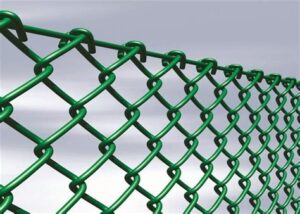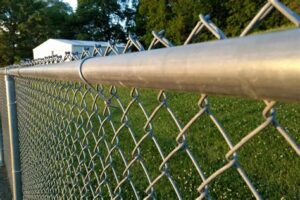Discover essential guidelines on chain link fence post placement, optimal spacing, installation best practices, and maintenance tips for lasting quality.
When it comes to building a robust and reliable chain link fence, understanding the intricacies of post placement is crucial. The distance between each fence post directly impacts the durability, stability, and overall aesthetics of your enclosure. This article will delve into the essential requirements for chain link fence post distance, highlighting key factors that influence placement decisions and offering insights into optimal spacing calculations. With best practices for installation and maintenance overview, we aim to equip you with the knowledge needed to ensure your chain link fence stands the test of time. Whether you’re a DIY enthusiast or a seasoned professional, our comprehensive guide will provide invaluable tips to enhance your fencing project. Let’s explore how proper post distance can elevate the quality and longevity of your chain link fence.
Understanding Chain Link Fence Post Distance Requirements
When planning to install a chain link fence, one of the most critical elements to consider is the distance between the posts. Proper spacing is essential to ensure the fence’s stability, functionality, and overall aesthetic appeal. Typically, the standard distance between chain link fence posts is between 5 to 10 feet, depending on various factors.
chain link fence post distance, First, assess the height of the chain link fence you intend to construct. Generally, taller fences require closer post spacing for added support. For instance, a 4-foot high fence may be adequately supported by posts spaced 10 feet apart, while a 6-foot fence might necessitate a distance of only 5 to 7 feet between posts.
Another crucial aspect is the type of soil and the environmental conditions in your area. Soft or sandy soils may not hold posts securely; therefore, reducing the distance between posts will enhance the fence’s durability. Conversely, in stable, firm soil, wider spacing may be adequate.
It’s also important to consider the local regulations and building codes, as some areas may have specific requirements regarding the maximum allowable distance between fence posts. Always check your local guidelines to ensure compliance and avoid future complications.
If the fence will be subjected to external stresses, such as high winds or heavy vegetation, adjusting the post distance accordingly can significantly improve its resilience. By understanding and applying these chain link fence post distance requirements, you’ll create a sturdy and long-lasting fence that meets both functionality and aesthetic needs.
Factors Influencing Chain Link Fence Post Placement
chain link fence post distance, When determining the appropriate distance between chain link fence posts, several factors come into play that can significantly affect both the functionality and longevity of your fence. Understanding these factors can help you make more informed decisions for your fencing project.
- Terrain Type: The nature of the land where your fence will be installed is crucial. If the area is uneven or hilly, you may need to adjust post spacing to accommodate changes in elevation.
- Climate Conditions: Areas that experience high winds or heavy snowfall may require closer post spacing to enhance the structural integrity of the chain link fence.
- Fence Height: Taller fences generally need closer post spacing to prevent sagging or bending over time.
- Local Building Codes: It’s essential to check local regulations, as they may dictate specific spacing guidelines for chain link fence installations.
- Purpose of the Fence: Depending on whether the fence is meant for security, containment of pets, or simply as a boundary marker, the post placement may vary.
By taking these factors into account, you can optimize the placement of your chain link fence posts for best performance and durability.
Calculating Optimal Spacing for Chain Link Fence Posts
When installing a chain link fence, one of the most critical factors to consider is the spacing between your fence posts. The optimal distance not only ensures the stability of the fence but also enhances its overall aesthetic appeal. Here are some guidelines for calculating the ideal spacing:
- Standard Spacing: Typically, chain link fence posts are spaced 5 to 10 feet apart, depending on the height and type of fence being installed. For projects with taller fences, shorter distances between posts may provide better stability.
- Corner and End Posts: It’s essential to consider that corner and end posts should be placed closer together, often at 4 to 5 feet apart, as they bear additional tension from the fence fabric.
- Line Posts: Line posts can generally follow the 5 to 10 feet rule; however, it’s advisable to install them at 6-foot intervals for enhanced integrity.
Additionally, environmental factors such as soil type and weather conditions can influence your fence post spacing. For instance, in areas where soil has a high clay content, or locations exposed to strong winds, reducing the distance between posts enhances stability. Always account for these variables to calculate the optimal spacing for your specific situation.
Proper spacing for chain link fence posts is key to ensuring the longevity and functionality of your fence. Ensure you take the time to measure accurately and adjust according to your fencing needs.
Best Practices for Installing Chain Link Fence Posts
To ensure a sturdy and durable installation of your chain link fence, adhering to best practices for installing fence posts is crucial. Here are some guidelines to help you achieve the best results:
- Choose the Right Materials: Opt for high-quality materials that are specifically designed for chain link fences. This includes galvanized steel posts and compatible fittings that can withstand the elements.
- Correct Depth and Width: When digging post holes, ensure they are deep enough—usually about one-third of the post length—and wide enough to accommodate gravel and concrete if used. A common recommendation is a minimum depth of 2 feet for residential fences.
- Use Proper Spacing: Follow the guidelines for post spacing, which typically range from 5 to 10 feet apart. Proper spacing is essential for maintaining the structural integrity of the chain link fence.
- Install Corner and End Posts First: Begin with the corner and end posts since they provide stability and help in maintaining the alignment of the fence. Ensure these posts are plumb before securing them.
- Check Levels and Alignment: As you install each post, check that they are level and aligned with one another. This will help prevent any sagging or misalignment in the fence.
- Secure Posts Properly: Use concrete or gravel to secure the posts in place firmly. If using concrete, give it adequate time to cure fully before attaching the chain link fabric.
- Install the Chain Link Fabric: Once the posts are set, attach the chain link fabric starting from one end and work your way to the other, securing it tightly to prevent sagging.
- Inspect Your Work: After installation, perform a thorough inspection to check for any loose fittings or misaligned sections. Make adjustments if necessary.
By following these best practices, you can ensure that your chain link fence is both functional and visually appealing, effectively meeting your needs for security and boundary definition.
Maintaining Chain Link Fence Quality Through Proper Post Distance
To ensure the longevity and durability of your chain link fence, maintaining the correct post distance is crucial. Proper spacing directly correlates with the overall stability of the fence and prevents potential issues such as sagging and bending.
When chain link fence posts are spaced too far apart, the tension of the fencing material may lead to increased stress at each post, making the structure more susceptible to damage from wind, weather, and other environmental factors. Conversely, if posts are placed too closely together, it can lead to unnecessary material use and increased labor costs.
Here are some key practices to maintain the quality of your chain link fence through proper post distance:
- Regular Inspections: Periodically check the posts and fence fabric for signs of wear or instability. Look for leaning posts or loose fittings that could indicate issues with spacing.
- Adjustments: If you notice that the fence is sagging or has begun to lose its shape, consider tightening the tension on the fabric or adjusting the post positions if necessary.
- Upgrade Materials: Using galvanized steel posts or heavier gauge wire for the chain link can help provide better support and reduce wear, particularly in areas with heavy winds or other challenging conditions.
- Weather Consideration: In regions with heavy snowfall or rain, ensure that the posts are adequately anchored in the ground, as increased weight can affect the distance and positioning over time.
- Follow Local Regulations: Always ensure that your post spacing complies with local building codes or guidelines, as regulations may differ based on location and fence purpose.
By adhering to these practices, you can ensure your chain link fence remains sturdy and functional over time, providing security and property delineation with minimal maintenance. Keeping the posts at optimal distances isn’t just a suggestion; it’s a key component in the structural integrity of your fencing. Proper planning and installation play an essential role in the performance and lifespan of your chain link fence.
Frequently Asked Questions
What is the standard distance between chain link fence posts?
The standard distance between chain link fence posts is typically 10 feet apart. However, in some cases, this distance can vary depending on the specific requirements of the fence design.
Why is the distance between posts important?
The distance between posts is important because it affects the fence’s stability, strength, and overall appearance. Proper spacing ensures that the fence can withstand environmental factors such as wind and pressure.
What materials are needed to install chain link fence posts?
To install chain link fence posts, you typically need chain link fencing fabric, galvanized chain link posts, concrete for anchoring, fittings such as tension bands and barbed wire, and tools like a post hole digger, level, and measuring tape.
Can the distance between chain link fence posts be customized?
Yes, the distance between chain link fence posts can be customized based on specific project needs or local regulations. In some cases, posts may be set closer together for added strength or to accommodate curves in the fence line.
What factors should be considered when determining post spacing?
Factors to consider include the height of the fence, local weather conditions, soil type, and the type of chain link fencing being used. These factors can influence the strength and durability of the installed fence.
How do I calculate the number of posts needed for my chain link fence?
To calculate the number of posts needed, measure the total length of the fence and divide it by the distance between posts (usually 10 feet). Remember to account for corner, line, and end posts, which may require additional materials.
Is it necessary to set chain link posts in concrete?
While it is not mandatory, setting chain link posts in concrete is highly recommended for increased stability and longevity, especially in areas with heavy winds or poor soil conditions.





